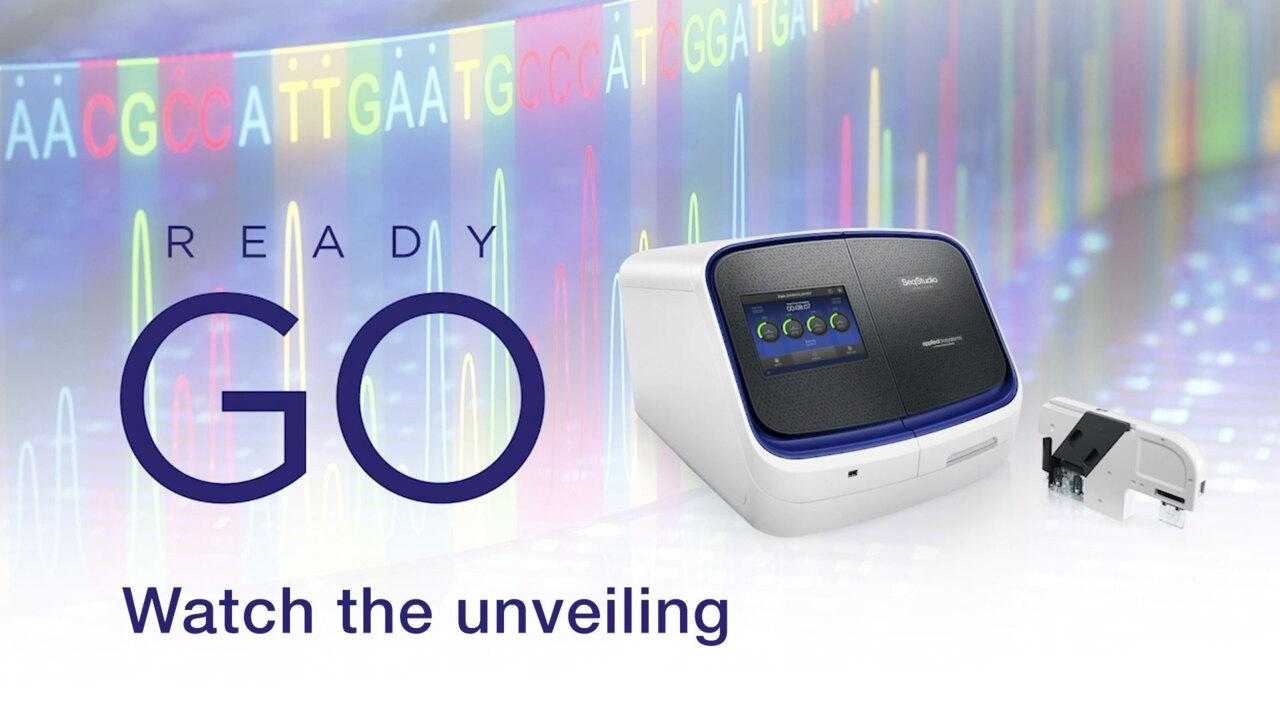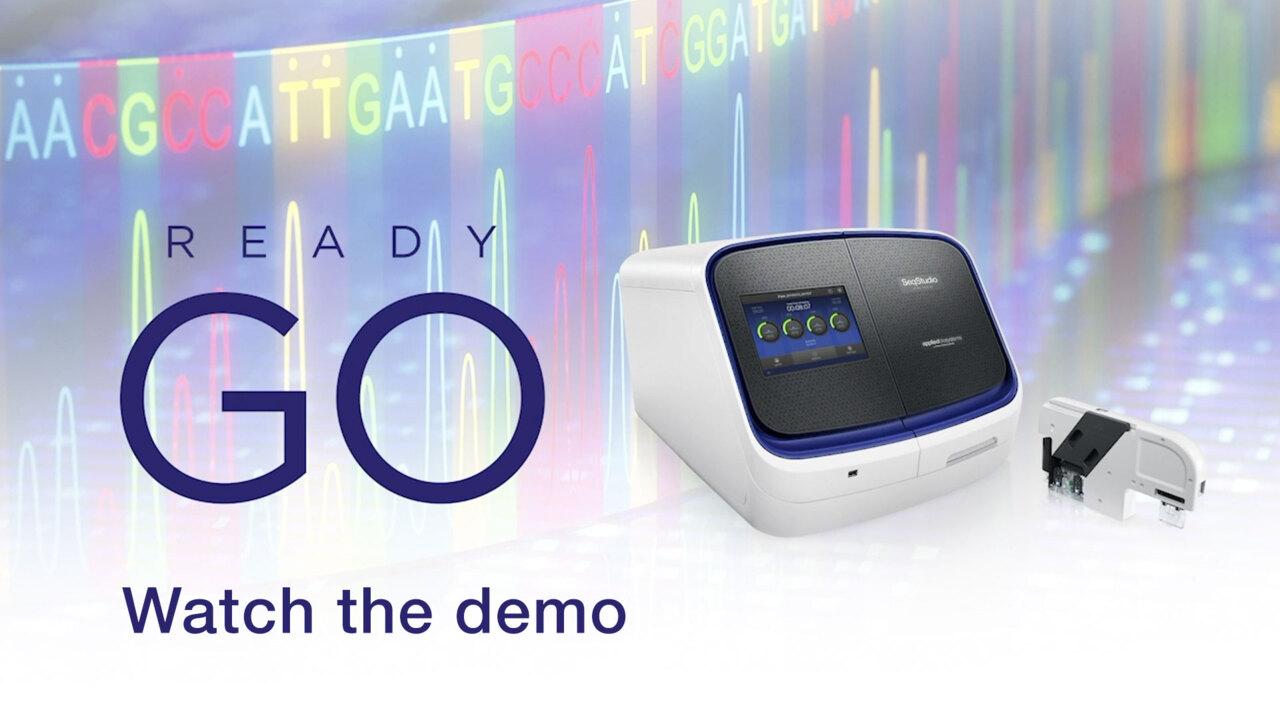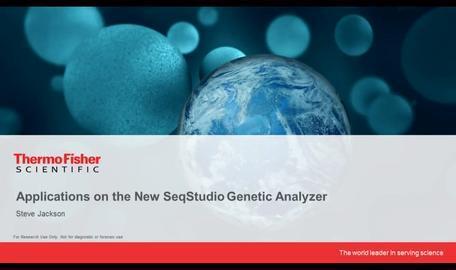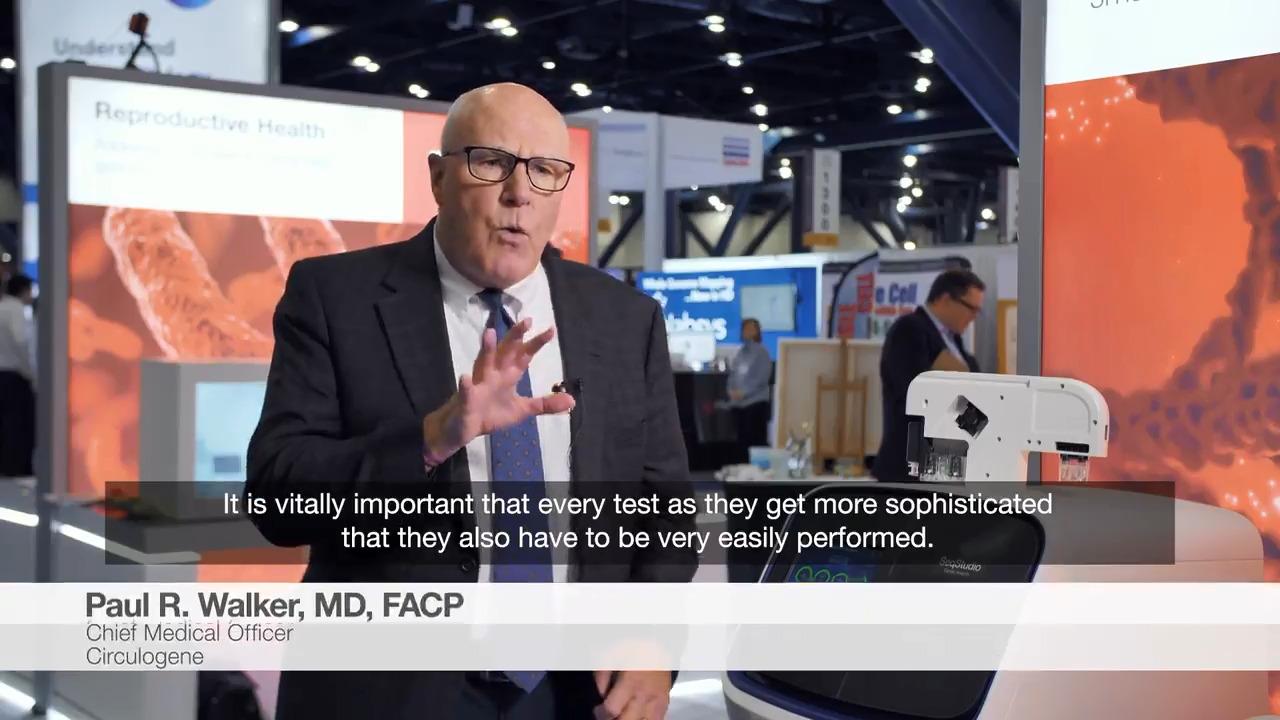Search Thermo Fisher Scientific

Simple, fast, low-throughput Sanger sequencing and fragment analysis system
The Applied Biosystems SeqStudio Genetic Analyzer is a low-throughput, easy-to-use, and convenient benchtop system that delivers gold-standard Sanger sequencing technology and fragment analysis by capillary electrophoresis with a simple click. Just load your samples, click in the innovative all-in-one cartridge, and go.
The SeqStudio instrument is easy to use across a broad range of applications, including de novo, targeted, and plasmid Sanger sequencing, CRISPR-Cas9 genome editing confirmation, cell line authentication, and detection of single nucleotide polymorphisms (SNPs). Setup is simple and you will be ready to go in minutes. The SeqStudio Genetic Analyzer offers data quality, usability, service, and support at an affordable price.
Need higher throughput? Like the SeqStudio instrument, our SeqStudio Flex Genetic Analyzer is an easy-to-use, flexible system for Sanger sequencing and fragment analysis, but with higher throughput.
Features
The SeqStudio Genetic Analyzer is designed for both new and experienced users who need simple and affordable Sanger sequencing and fragment analysis, without compromising performance or quality.
Innovative all-in-one cartridge
Just load your samples, insert the cartridge, and go— no need for technical experts for set-up or maintenance
Fast turnaround
Complete your run in as little as 30 minutes
Optimized end-to-end workflow
Single polymer system allows for Sanger sequencing and fragment analysis samples to be run on the same plate in the same workflow with no reconfiguration
Touchscreen usability
The intuitive touchscreen interface simplifies plate, sample, and run setup and displays results in a choice of formats
Connectivity with Thermo Fisher Connect
Manage your run anytime, anywhere from Thermo Fisher Scientific’s Connect cloud-based platform
Comprehensive analysis software
Primary and secondary analysis software modules are available for download or through Thermo Fisher Connect
Traceability and data security module
Optional security, audit, and electronic signature (SAE) software module offers an electronic data chain of custody to help ensure integrity of your data
SmartStart customer orientation
Every SeqStudio instrument purchase includes a one-day, on-site SmartStart Orientation training course to get you up and running quickly
Learn more about these features:
The SeqStudio Genetic Analyzer uses an innovative all-in-one cartridge that includes the capillary array, anode buffer, and a reservoir containing polymer for both sequencing and fragment analysis applications. Load your samples, click in the cartridge, and go—there’s no need for expert setup or maintenance, no calibration before each run, and no installation of individual components. The reagents on the cartridge are stable on the instrument for 4–6 months, depending on the reaction size of the product.
Individual cartridges can be designated for different experimental designs or different researchers, enabling multiple users to share a single SeqStudio Genetic Analyzer. The cartridge system allows you to use only what you need and avoid unnecessary waste without sharing experimental reagents. The catridge can also be recycled.*
*Cartridge recycling available in selected regions only. For details, visit thermofisher.com/seqstudiorecycling.
The integrated, interactive touchscreen helps you set up plates and samples, create or modify run modules, change run module priorities, and start and manage the run. View results in a choice of formats, including list view, plate view, and sequencing plots or electropherograms. Multiple views can help increase confidence in your experimental data.
SeqStudio data collection software contains an optional security, audit, and electronic signature (SAE) module that offers an electronic data chain of custody. The SAE module helps ensure the integrity of your data by defining security settings for each user account, incorporating comprehensive auditing of data objects, and requiring authentication for changes. All settings are customizable to help meet your laboratory requirements.
The SAE module supports electronic record-keeping in a way that is compliant with the US Food and Drug Administration’s Electronic Records and Signatures Rule, Part 11 of Title 21 of the Code of Federal Regulations (21 CFR Part 11). To achieve 21 CFR Part 11 compliance, your institution will also need to establish and document standard operating procedures in a compliant way.
The SAE application requires a standalone computer purchased from Thermo Fisher Scientific (desktop or laptop versions are available) and must be enabled on-site by a field service engineer.*
*If the optional SAE software module is enabled, cloud connection is disabled and remote access is unavailable.
Applications
Sanger sequencing is the gold standard for sequencing technology, enabling a high degree of accuracy, long-read capability, and the flexibility to support a diverse range of applications in many research areas. Similarly, analysis of DNA fragments enables a multitude of applications, from genotyping to bacteria identification and from plant screening to gene expression profiling.
Below are examples of applications that can be run on the SeqStudio Genetic Analyzer. For more application information, see our SeqStudio Applications page.
De novo Sanger sequencing |
Targeted Sanger sequencing |
Plasmid sequencing |
Oncology research |
Microbial species identification |
Next-generation sequencing (NGS) confirmation |
CRISPR-Cas9 genome editing analysis |
Human cell line authentication |
Single-nucleotide polymorphism (SNP) genotyping |
Analysis of human copy number variation (CNV) |
DNA methylation analysis |
Low-level somatic variant detection and analysis |
Microsatellite instability (MSI) analysis |
Repeat DNA expansion |
SARS-CoV-2 identification |
|
Learn more about these applications:
There are two points in the CRISPR-Cas9 (or TALEN) genome editing workflow where the edits need to be verified. First, after the intial editing procedure, a primary screen of the resulting mixed culture can determine the percentage of cells containing the edit (editing efficiency). If the edited cells are then purified or subcloned, a secondary screen can help ensure that all cells in the subcloned population contain the edit. Sanger sequencing using the SeqStudio Genetic Analyzer can perform both of these screens as one component of Thermo Fisher Scientific’s end-to-end portfolio of genome editing tools and reagents.
In the primary screen shown in the figure below, whole-cell lysates were obtained from HEK293 cells that were edited to introduce random deletions around a target site in the HPRT or relA locus. To confirm the position of the edit, the edited cells were sequenced on the SeqStudio Genetic Analyzer and the Sanger sequencing traces were uploaded to the cloud and analyzed using the Sanger Variant Analysis module. In the screen image showing the HPRT locus, the position of the edit is clearly indicated and can be visualized by the abundant mixed-base peaks downstream of the break.
While Sanger Variant Analysis clearly showed the breakpoint and random deletions, it cannot calculate overall editing efficiency. To do so, the Sanger sequencing trace files were analyzed using Tracking of Indels by Decomposition (TIDE) software, a widely available tool for analyzing the efficiency of genome editing events. The graphs below show the spectrum and frequencies of deletions at each locus. The frequencies confirm results obtained using Invitrogen TOPO cloning followed by Sanger sequencing results of the same edited cell populations.
Analysis of two different genome editing events at the HPRT and relA loci using TIDE software. Events at the HPRT and relA loci were analyzed using TIDE software and mixed population sequencing traces generated by the SeqStudio Genetic Analyzer. The bars show the proportion of the population having the indicated number of nucleotides deleted or inserted in the forward direction (which was nearly identical to the reverse direction; data not shown). For (A) HPRT, the overall efficiency of the edit in both directions was about 80%, whereas the overall efficiency at the (B) relA locus was about 20%.
Although the study of human diseases relies heavily on dissociated human cell lines grown in culture, cells grown in vitro can be misidentified or contaminated with other unrelated cell lines, to the extent that funding agencies and journals now require cell line authentication (CLA) before awarding grants or approving publications. One way to verify the authenticity of a cell line is to identify and match its highly specific genetic “fingerprint” of variable short tandem repeats (STRs) on the SeqStudio Genetic Analyzer.
In the workflow, the IdentiFiler Plus or IdentiFiler Direct kit is used (with purified or crude DNA preparations, respectively) to amplify 16 highly variable human STR loci commonly used for verifying cell line authenticity (as well as forensic science). The fragments are analyzed on the SeqStudio instrument using GeneMapper or Microsatellite Analysis software to characterize the alleles identified by the Identifiler kits, and the results can be used to query ATCC or other STR databases to verify authenticity.
In this test of the ability of the SeqStudio Genetic Analyzer to detect contaminating cells, a population of M4A4GFP cells was spiked with varying amounts of HeLa cells and analyzed using the IdentiFiler Direct kit (workflow B). HeLa cell-specific alleles could be detected even if HeLa cells made up only 10% of the population.
Optimized end-to-end workflow
The SeqStudio Genetic Analyzer can perform both Sanger sequencing and fragment analysis runs on the same plate within the same workflow. Gain flexibility in your laboratory schedule and help maximize your time by removing the need to batch samples.
We offer a complete product portfolio for every step of the Sanger sequencing and fragment analysis workflows. For Sanger sequencing, this includes amplifying the DNA template, PCR cleanup, cycle sequencing, sequencing cleanup, on‑instrument consumables, and data analysis. For fragment analysis, this includes DNA extraction, PCR amplification, on‑instrument consumables, and data analysis.
Videos, webinars, and demos
Specifications
- SeqStudio Genetic Analyzer System specifications
- SeqStudio Cartridge specifications
Attribute |
Description |
Number of capillaries |
4 |
Number of dyes |
6 |
Sample format |
96-well standard plate and standard 8-tube strips |
Applications |
|
Secondary analysis software included |
|
Warranty |
Included (1 year) |
In-lab application training |
Included |
Attribute |
Description |
Capillary array length |
28 cm (works with POP-1 polymer to resolve short and long reads) |
Polymer type |
Universal polymer POP-1 (for performing sequencing and fragment analysis) |
Maximum number of injections/reactions |
Up to 125 injections/500 reactions or sample (A33671) |
On-instrument shelf life |
4 or 6 months after opening |
Available in most regions |
|
On-instrument tracking |
RFID (radio frequency identification) |
Services
Superior services and support for the SeqStudio Genetic Analyzer
Choose a service plan that’s right for you. Help maximize system uptime, reduce repair costs and turnaround time, extend the life of your instrument, and help keep it running at peak performance with one of our comprehensive service plans. Choose from a variety of service options that balance your budget, productivity, uptime, and regulatory requirements. When it comes to superior services and support for your SeqStudio Genetic Analyzer, we’ve got your back.
SmartStart Orientation enables your success
Every SeqStudio Genetic Analyzer includes a one-day, on-site SmartStart Orientation to get you up and running quickly. Led by a field applications scientist (FAS) at your location, this interactive training provides an overview of instrument operation and maintenance, data collection and analysis software, cloud connectivity, data troubleshooting, and more.
Comprehensive warranty and service plans protect your investment
SeqStudio Genetic Analyzers are protected by a standard one-year factory warranty that covers necessary costs for travel, labor, and parts. Extended-coverage service plans are available at the time of instrument purchase. Keep your laboratory running smoothly with preventive maintenance, proactive instrument monitoring, and fast response time that’s included with one of our superior service plans.
Service plan overview
Service aspect |
AB Maintenance (Plus) plan |
AB Assurance plan |
AB Complete plan |
On-site response time |
Target 2 business days* |
Guaranteed 2 business days* |
Guaranteed next business day* |
Scheduled on-site planned maintenance |
✓ |
✓ |
✓ |
Remote instrument diagnostics |
✓ |
✓ |
✓ |
Parts, labor, and travel |
10% discount (US only) |
✓ |
✓ |
Priority access to remote service engineer |
|
✓ |
✓ |
Requalification, post-planned maintenance (PM) and critical repairs |
|
|
✓ |
Troubleshooting by field application scientist |
|
|
✓ |
*Response times vary by region
All service plans include scheduled planned maintenance and the latest software updates, enabling optimum reliability. Service plans help keep operating costs predictable, as parts, labor, and engineer travel are included or discounted.
Qualification services help ensure regulatory compliance
Instrument hardware qualifications for SeqStudio Genetic Analyzers include installation qualification (IQ), operational qualification (OQ), and instrument performance verification (IPV) services. Our qualification specialists will partner with you to deliver timely, cost-effective, and trusted qualification services that include reliable, audit-style documentation to help ensure your SeqStudio Genetic Analyzer meets regulatory requirements.
Resources
Documentation and literature
Brochure
Application guide
Specification sheet
Blog posts
Customer education
Sanger sequencing
Fragment analysis
Ordering information
For Research Use Only. Not for use in diagnostic procedures.




